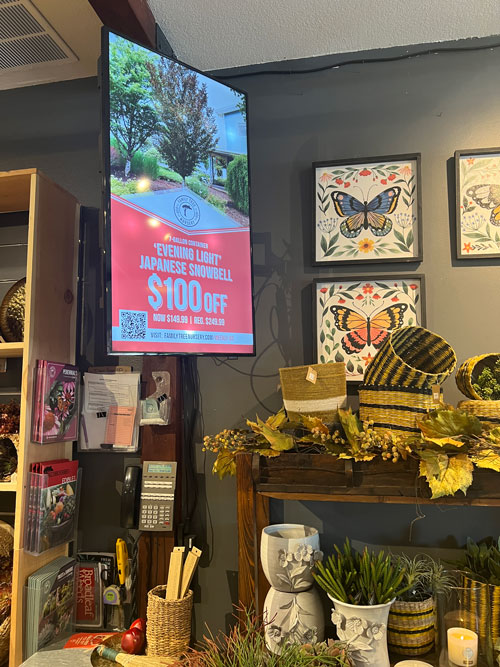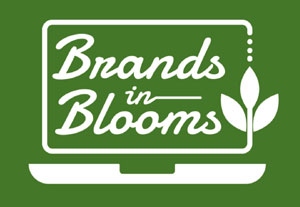4/1/2024
Cultivating a Future in Garden Retail
Jeff O’Brien

Garden retailers are facing a critical challenge as the shift from traditional customers to fresh-thinking Millennials (and younger generations) reshapes the future of how the horticulture industry evolves.
As the demographic landscape of our society shifts, so too must the strategies of garden retailers and how they connect with this new wave of customers. The spotlight now turns largely to the Millennials, those born between 1980 and 2000 and who in 2022 surpassed Baby Boomers as the largest U.S. generation.
Pictured: An example of using digital offerings in-store to upgrade the shopping experience.
These Millennials, once often the object of societal ridicule, now hold high-paying jobs and tremendous spending power and live in homes that need the help of a garden retailer. The largest demographic in history, often considered uninterested in traditional pastimes such as gardening, now holds untapped potential to invigorate this sector.
The task ahead of us business leaders is straightforward yet complex: to bridge the gap between the rich heritage of gardening, and the values and lifestyles of the younger generation. To do this, we must reimagine our approach. If we can connect with this new generation of gardeners, we can reach new revenue levels while ensuring that the timeless art of gardening continues to flourish.
I’m A Millennial Reaching Millennials
I love the horticulture industry. Some of the best people I know work tirelessly to serve the market. As a Millennial with over 10 years of retail sales experience, I’ve noticed that while our society has changed in many ways, the way we run our garden centers has not budged. Burdened to help our industry shift, I recently completed an MBA focusing on how garden centers can evolve to ensure they reach a growing market and a bright future for their business.
Understanding what motivates Millennial consumers to visit garden centers was central to my study. I interviewed a diverse group of Millennial gardeners and those interested in gardening to uncover their preferences in a garden center. My research tackles a pressing issue in the horticultural industry: rejuvenating an aging consumer base by engaging younger generations.
The study offers practical strategies for garden centers to become more attractive to Millennials, benefiting the garden centers, their brands and their clientele. My findings emphasize the pivotal role of the Millennial generation in shaping the future of retail garden centers as the traditional, older consumer base begins to wane. One owner noted, “I think that the consumers that are the older generation, which is 55 and older, are going to continue to be dropping out of existence.”
This observation is further supported by another interviewee who specializes in nursery sales to garden centers. He remarked, “We’re seeing the growth in the market coming from the younger generation ...” These statements underscore the importance of engaging younger customers for the industry’s growth and sustainability.
Here’s What We Found Talking To Millennials
The research indicates that the relationship between retail garden centers and consumers is foundational to mutual success, with inspiration and education emerging as pivotal elements.
The importance of education: A notable finding from the study is how educational initiatives within garden centers can significantly boost revenue. This encompasses a range of activities, from workshops on specific gardening techniques to promoting eco-friendly planting options.
One participant highlighted the effectiveness of this approach, stating, “We do a lot of events and make it educational, so that tends to bring people in. And then when they get to the garden center, they certainly walk around and do shop after the workshop.”
This insight from a garden center buyer underscores the draw of educational events in attracting customers.
One young homeowner’s admission further illustrates the importance of education: “I kill everything. I wish I could garden, but I suck. But I just buy lots of plants and then it seems like I know how to grow them. No one knows that they keep dying.”
This remark sheds light on a common challenge faced by many would-be gardeners—it shows us the critical role education plays in enhancing the customer experience and empowering consumers.
By providing the knowledge and tools necessary for successful gardening, retail garden centers can foster a deeper connection with Millennials, who often seek learning opportunities as a critical part of their purchasing process.
Improve the customer experience: Millennials love to experience the world around them. We can travel more than any previous generation. Our world is sensory and garden centers can scratch the experiential itch. Creating a memorable customer experience is crucial for attracting Millennials to garden centers.
One owner who’s mastered the art of the customer experience highlighted to me, “We were all about creating an experience. It’s where we need to be,” pointing to a shift from just selling products to offering immersive experiences.
Consumers echo this, with one sharing with me, “I genuinely love going into garden centers ...” and another willing to travel for a unique visit: “I will travel ... just to walk around and it’s like going to a park.”
These comments underline the importance of engaging environments that draw a wider audience, encourage loyalty and boost sales. Focusing on a customer experience that connects, inspires and delights is critical to making garden centers appealing to Millennials, ensuring the industry’s growth and relevance.
Going missing on social media: Too many garden centers are missing a tremendous opportunity to connect with younger buyers because they’re invisible or irrelevant on social media. Also, you’re invisible to prospective new customers if you’re not on social media.
I know it’s not your favorite part about running a business, but being active on social media isn’t just a strategy for garden centers; it’s a survival tactic. This is especially true when the new target market considers Wi-Fi as essential to existence as sunlight and water are for plants.
According to my study, while social media is pivotal in sparking interest and guiding discovery, it’s only one piece of the puzzle. One participant said, “I feel like I’ve done all the research. I’m interested in following gardening influencers on Instagram, but I never follow through with it.”
My study revealed a curious phenomenon: despite extensive online research and a professed interest in gardening, only a fraction of these digital natives visit a garden center.
The reasons? Participants confessed to fear of failure and the dread of investing in a hobby where their plants might die an untimely death. This underscores a unique challenge: bridging the gap between online engagement and in-store action. For garden centers, then, cracking the code of social media means showcasing lush landscapes and cultivating a narrative that encourages Millennials to swap their screens for getting into the soil itself. The most valuable connections remain on the ground in a world dominated by likes and shares.
Confusing in-store retail design layouts: Most garden centers spend a lot of time, energy and money thoughtfully arranging their products—from perennials arranged alphabetically to shrubs grouped by variety. This speaks to the importance placed on visual presentation.
Here’s the problem we discovered: this traditional approach seems to miss the mark with younger shoppers. Many garden center buyers observed that these conventional layouts lead to confusion rather than clarity. The study also shed light on the importance of in-store retail design layouts in garden centers, highlighting it as a vital factor for attracting customers and ensuring business success.
The feedback suggests a disconnect between current store design strategies and the preferences of younger generations, particularly Millennials, who may be looking for a more intuitive and engaging shopping experience. The consensus among buyers is clear: garden centers must innovate and rethink their physical layouts to draw in younger homeowners. This revelation points toward a broader adaptation trend, underscoring the need for garden centers to evolve with their consumer base’s changing tastes and expectations.
“I kill everything. I wish I could garden, but I suck. But I just buy lots of plants and then it seems like I know how to grow them. No one knows that they keep dying.” —Millennial focus group participant
It’s not just about rearranging plants; it’s about cultivating an environment that resonates with a new generation of gardeners, inviting them to explore, learn and invest in their gardening journey.
The study underscores garden centers need to focus on educational programs, memorable shopping experiences, strong social media engagement and modernized in-store layouts to attract Millennials. By addressing Millennials’ desire for knowledge, unique experiences and digital inspiration while simplifying shopping layouts, garden centers can align with the expectations of a younger, more connected, consumer base.
Here’s What I Recommend
A transformational change will need to occur for the retail garden center to defend against an aging consumer group and attract the younger generation into the industry. The main areas of transformation are the website, social media and the in-store layout. The study suggests that consumers and potential consumers are active online, but aren’t seeing enough online value to remove the fear, educate, build trust and inspire them into the garden center.
For retail garden centers to attract and retain the younger generation, the website, social media and in-store layout must be built on consumer lifestyles and needs.
1. Develop a fresh consumer marketing strategy. Finding a new customer focus that thinks, values and shops differently will lead to a new way of communicating with customers. Your latest message should invoke an emotional connection with emerging consumers. This message should be showcased throughout the website, social media and in-store layout.
2. Adapt a new design strategy in-store and online. I recommend changing your design strategy to echo your marketing efforts, creating a seamless experience across your website, social media and physical store.
Move away from traditional organization methods like alphabetical or genus-based listings towards intuitive categories that educate and inspire. This unified approach should evolve with the seasons, reflecting the beauty of the current flora and fostering a deep, emotional connection with shoppers by resonating with their lifestyles. By doing so, you’ll facilitate a more engaging learning environment and ensure both novice and expert gardeners find success and satisfaction in your updated design. This redesign aims to transform the space and the consumer experience, guiding them through a journey of discovery and connection within your garden center. GP
 If You Need More Help, I’m Here For You
If You Need More Help, I’m Here For You
I was so passionate about this research and the opportunity it presents to garden centers that I started a company devoted to helping. My company, Brands in Blooms, aims to tackle the challenge of drawing younger customers to garden centers. We offer garden centers a complete package: marketing consulting, modern website design and social media management. We focus on what Millennials like, ensuring everything from online to in-store reflects their interests and lifestyles. See how we do it and how it can work for you by checking out examples of our work at demo.brandsinblooms.com.
Jeff O’Brien is an MBA grad from Manchester Metropolitan University. As Director of Sales at Van Belle Nursery, he led a team that doubled the business in five years. Today, as a business coach and the mind behind Brands in Blooms, he’s dedicated to helping your business flourish. You can contact Jeff at Jeff@brandsinblooms.com and visit brandsinblooms.com.